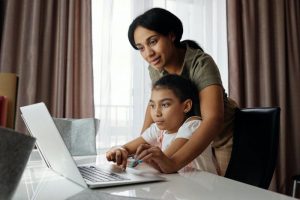With apologies to Bob Dylan, the times they are a’ changing. And nowhere are they changing faster or with more potentially critical consequences than in education – both the public and private sectors – in-person versus home learning. Which is best? With vaccines being circulated, double-masking and social distancing being complicated by more virulent strains of COVID, the questions are getting more confusing rather than less. As more school districts open their doors for in-person classes, should you keep your student working online, or go back to in-person classrooms once and for all?
Several things to keep in mind about the following pros and cons:
1) I teach and am licensed to teach in the US, and while about 15% of my total student number (both Takelessons and other partner companies) are outside the U.S., I am much less familiar with the types of protocols going on in other countries at the moment.
2) Even within the U.S., protocols and how efficiently and effectively those protocols are enforced vary widely between states, counties, and even districts.
3) These observations and suggestions are not intended to be medical advice. They are meant to merely share some of my observations and help you logically evaluate your student’s needs and risks regarding home learning or in-person school.
The Pros of Going Back to In-Person Classrooms
- Schools and Districts are learning from nearly a year of sometimes hit or miss protocols, using cleaning, sanitizing, masking, and social/classroom distancing to minimize risk. And enforcing quarantines (by not letting students back to class for 2 weeks when testing positive or being exposed to the virus).
- Teachers and curriculum development specialists in physical schools are often more cognizant and familiar with state requirements, admission needs of colleges, and standardized tests and test prep.
- Regardless of where you stand on the socialization factor of in-person schooling vs. homeschooling, after nearly a year of separation from many of their classmates, students may appreciate and even need the social reinforcement of friendships, albeit in a monitored protocol.
The Cons of Going Back to In-Person Classrooms
- Questions, questions, questions: Will the variants of Covid-19 just hitting the United States and a number of other countries have any effect on the preventative protocols already in place?
- And even with those questions put aside, there are very real concerns about the actual enforcement of those protocols. As a long-term substitute at a well-respected high school in an equally well-respected school district in the early stages of going back to school in COVID-time, I can tell you with certainty that their diligent protocols, strictly enforced on-campus, fell apart as soon as students left campus, hundreds of them immediately taking off masks and milling amongst each other. Some adjustments to security were consequently made, but it raises many more questions than it answers.
- For family members tasked with teaching their children, or at least helping them with online lessons, there are literally hundreds of online programs, websites, blogs, and other places online to get help. For both you and your student. For free, or small fees. It absolutely requires you doing your due diligence to sort through what can seem overwhelming, but most often your student’s teacher or school district will be happy to help you prioritize it, or even just to help you understand the material.
- You, as a parent/guardian, will have a more complete view of what your student is learning and exposed to in those curricula. As well as a gauge of how well they’re doing, separate from the teachers’ evaluations.
So let’s look at the question again. Should you send your kid(s) back to school, or keep them in home learning?
Short answer: It’s complicated. Longer (and more useful) answer: Your situation at the moment is really the key. Do you have a situation that allows you to supervise your student at home? At the very least you will probably need to oversee curricula he/she is working on, and be available for the inevitable questions when the teacher might not be around or answering emails immediately. For some that is not feasible.
As with most decisions in any walk of life, information is king. Since Covid-19 arrived, the sources we look to for medical and safety advice have exploded, both in complexity and conviction. The Center for Disease Control (CDC) has been collating information and working on standardizing protocols for Covid, including its newer variants, and has a pretty phenomenal group of web pages with information updated regularly and can be found here, including a “school/childcare decision tool.” And since nearly all school districts are guided by the CDC, most people can be on the same page.
Regardless of what decisions you make for (and with) your student, please be careful, be safe, and have patience. Be good to people, and be good to yourself too.
Larry Paullin


